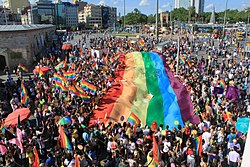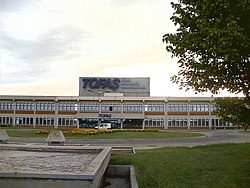Draft:Ista-Burs
| This is a draft article. It is a work in progress open to editing by anyone. Please ensure core content policies are met before publishing it as a live Wikipedia article. Find sources: Google (books · news · scholar · free images · WP refs) · FENS · JSTOR · TWL Last edited by JBchrch (talk | contribs) 5 hours ago. (Update)
Finished drafting? or |
The topic of this draft may not meet Wikipedia's general notability guideline. (June 2025) |
Ista-Burs | |
|---|---|
Megalopolis | |
 Modern Istanbul skyline at sunset | |
| Country | Turkey |
| Region | Marmara Region |
| Major metropolitan areas | Istanbul, Bursa, Kocaeli, Sakarya, Tekirdağ, Yalova |
| Area | |
• Total | 31,000 km2 (12,000 sq mi) |
| Population (2025) | |
• Total | 22,376,297 |
| • Density | 720/km2 (1,900/sq mi) |
| Time zone | TRT (UTC+3) |
The Ista-Burs megalopolis, also known as the Marmara Megaregion, is a densely populated megalopolis in northwestern Turkey, encompassing the metropolitan areas of Istanbul, Bursa, Kocaeli, Sakarya, Tekirdağ, and Yalova.[1]
The region functions as Turkey's primary hub for commerce, industry, logistics, and culture, with over 22 million inhabitants.[2] It straddles the continents of Europe and Asia, anchored by Istanbul’s role as a global city.[3]
Geography
[edit]
The Ista-Burs corridor spans approximately 31,000 square kilometers and includes coastlines, river basins, plains, and highlands.[4] It lies at the intersection of the Sea of Marmara, Thrace, and the western edges of Anatolia.
One of the most defining features is the North Anatolian Fault, which runs through the southern outskirts of Istanbul and directly under Sakarya.[5] Major earthquakes such as the 1999 İzmit earthquake have led to regional reforms in building codes and land use planning.
Demographics
[edit]
The total population of the Ista-Burs corridor exceeds 22 million, representing over one-fourth of Turkey’s population.[6] Migration from other Turkish provinces continues, particularly to Istanbul, Kocaeli, and Bursa.
Administrative Districts
[edit]Istanbul: Adalar, Arnavutköy, Ataşehir, Avcılar, Bağcılar, Bahçelievler, Bakırköy, Başakşehir, Bayrampaşa, Beşiktaş, Beykoz, Beylikdüzü, Beyoğlu, Büyükçekmece, Çatalca, Çekmeköy, Esenler, Esenyurt, Eyüpsultan, Fatih, Gaziosmanpaşa, Güngören, Kadıköy, Kağıthane, Kartal, Küçükçekmece, Maltepe, Pendik, Sancaktepe, Sarıyer, Şile, Şişli, Sultanbeyli, Sultangazi, Tuzla, Ümraniye, Üsküdar, Zeytinburnu
Bursa: Osmangazi, Yıldırım, Nilüfer, İnegöl, Gemlik, Mudanya, Mustafakemalpaşa, Karacabey, Orhangazi, Yenişehir, Kestel, Gürsu, Harmancık, İznik, Orhaneli, Keles, Büyükorhan
Kocaeli: İzmit, Gebze, Darıca, Çayırova, Dilovası, Kartepe, Derince, Körfez, Karamürsel, Gölcük, Başiskele, Kandıra
Sakarya: Adapazarı, Serdivan, Erenler, Akyazı, Sapanca, Karasu, Ferizli, Hendek, Arifiye, Kaynarca, Pamukova, Söğütlü, Taraklı, Geyve, Kocaali
Tekirdağ: Süleymanpaşa, Çorlu, Çerkezköy, Malkara, Muratlı, Hayrabolu, Saray, Şarköy, Ergene, Kapaklı, Marmaraereğlisi
Yalova: Yalova (central), Çınarcık, Altınova, Armutlu, Çiftlikköy, Termal
| Province | Population | Area (km²) | Population Density (per km²) |
|---|---|---|---|
| Istanbul | 16,200,000 | 5,461 | 2,967 |
| Bursa | 2,150,000 | 10,882 | 197 |
| Kocaeli | 2,120,000 | 3,626 | 585 |
| Sakarya | 598,000 | 4,878 | 122 |
| Tekirdağ | 138,000 | 6,190 | 22 |
| Yalova | 95,000 | 798 | 119 |
Economy
[edit]
Ista-Burs is the primary economic axis of Turkey, accounting for over 45% of national GDP.[8] Istanbul is the finance, logistics, and media capital of the country, home to Borsa Istanbul, multiple bank headquarters, and two international airports.
Bursa and Kocaeli form Turkey’s industrial base, leading in automotive, chemicals, textiles, and steel production.[9] Gebze houses one of Turkey’s largest Organized Industrial Zones (OIZs), and Oyak Renault and Tofaş operate major plants in Bursa.
Infrastructure
[edit]
Ista-Burs has the most advanced and integrated infrastructure in Turkey. The Marmaray Project links Europe and Asia via a submerged rail tunnel beneath the Bosporus. High-speed rail, metro networks, and freight corridors converge in Istanbul, Kocaeli, and Sakarya.[10]
Key projects include:
- Istanbul Airport – one of the world’s busiest aviation hubs
- Osman Gazi Bridge – connecting Gebze to Yalova over the Sea of Marmara
- North Marmara Motorway – bypassing the city to relieve congestion
Higher Education and Research
[edit]
The Ista-Burs region hosts some of Turkey’s most prestigious universities. Istanbul Technical University (ITU), Boğaziçi University, Marmara University, and Yıldız Technical University are based in Istanbul.[11]
Uludağ University in Bursa and Sakarya University in Adapazarı are also major academic hubs. Gebze Technical University specializes in advanced R&D and works closely with TÜBİTAK MAM (Marmara Research Center).[12]
Politics and Governance
[edit]The region is governed by six metropolitan municipalities under Turkey’s Metropolitan Municipality Law. Each city oversees zoning, transport, and environmental services. However, overlapping jurisdictions and centralized project approval often create political friction.[13]
Marmara Belediyeler Birliği (MMU) fosters cooperation through shared forums and regional planning workshops. Initiatives like the Marmara Urban Forum (MARUF) address climate action, mobility, and participatory governance across the corridor.[14]
Environment and Sustainability
[edit]
Environmental risks in Ista-Burs have increased due to rapid urbanization, industrial activity, and climate change. The 2021 Sea snot crisis in the Sea of Marmara highlighted marine ecosystem collapse due to untreated wastewater and industrial runoff.[15]
In response, municipalities have launched climate adaptation projects including afforestation, solar energy adoption, and smart water networks.[16] Kocaeli and Sakarya have adopted wetland and river basin restoration programs supported by EU IPA funds.[17]
Culture and Society
[edit]
Ista-Burs embodies a cultural blend of Ottoman, Balkan, Anatolian, and immigrant influences. Istanbul is the country’s leading cultural capital, home to institutions such as Istanbul Modern, İKSV, and SALT Galata.[18]
Bursa preserves Ottoman-era architecture and performing arts like Karagöz and Hacivat. Tekirdağ celebrates Thracian traditions in food and wine, notably its annual Rakı and Cherry Festival.[19]
Tourism and Landmarks
[edit]

Tourism across the Ista-Burs region spans history, nature, and wellness. Istanbul offers global heritage sites like Hagia Sophia, Blue Mosque, and Topkapı Palace. Bursa features the UNESCO-listed Cumalıkızık village and Uludağ ski resort.[20]
Eco-tourism is growing around Sapanca Lake, Acarlar Floodplain, and the thermal springs of Yalova. Infrastructure developments such as Galataport and the Tekirdağ Port Master Plan are expanding cruise and coastal tourism offerings.[21]
See also
[edit]- Marmara Region
- List of Metropolitan Provinces of Turkey
- Urban agglomeration
- Greater Tokyo Area
- Pearl River Delta Megalopolis
- BosWash
References
[edit]- ^ "Marmara Urban Forum – Reports". Marmara Belediyeler Birliği. Retrieved 2025-05-04.
- ^ "Marmara Bölgesi Nüfusu". TÜİK. Retrieved 2025-05-04.
- ^ "Istanbul Metropolitan Municipality Vision 2050". İBB. Retrieved 2025-05-04.
- ^ Prof. Dr. Atilla Yüksel (2022). Türkiye'nin Coğrafi Bölgeleri. MEB.
- ^ "Earthquake Risk Map of Turkey". AFAD. Retrieved 2025-05-04.
- ^ "Population Projections by Province – 2025". TÜİK. Retrieved 2025-05-04.
- ^ "Regional Population Estimates". TÜİK. Retrieved 2025-05-04.
- ^ Turkey Economic Outlook 2024 (Report). Turkish Industry and Business Association (TÜSİAD). 2024.
- ^ "Industrial Zones of Turkey". Ministry of Industry and Technology. Retrieved 2025-05-04.
- ^ "Marmaray Project Overview". TCDD. Retrieved 2025-05-04.
- ^ "QS World University Rankings 2024". Retrieved 2025-05-04.
- ^ "Gebze Technical University R&D Collaborations". Retrieved 2025-05-04.
- ^ "Local Governance Structure in Turkey". TBMM. Retrieved 2025-05-04.
- ^ "Marmara Urban Forum Official Site". Retrieved 2025-05-04.
- ^ "Turkey's Sea Snot Crisis Threatens Biodiversity". BBC News. 2021-06-08.
- ^ "Climate Action Strategy – Istanbul 2050". İstanbul Büyükşehir Belediyesi. Retrieved 2025-05-04.
- ^ "IPA Environment Projects – Marmara Region". European Commission. Retrieved 2025-05-04.
- ^ "Istanbul Biennial Overview". İKSV. Retrieved 2025-05-04.
- ^ Dr. Aylin Gültekin (2020). Food and Culture in the Thrace Region. Trakya University Press.
- ^ "UNESCO World Heritage Sites – Turkey". UNESCO. Retrieved 2025-05-04.
- ^ "Galataport Istanbul". Retrieved 2025-05-04.
External links
[edit]- Turkish Statistical Institute (TÜİK)
- Marmara Urban Forum (MARUF)
- Ministry of Development – Regional Plans
